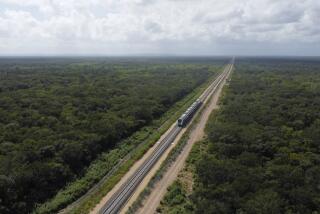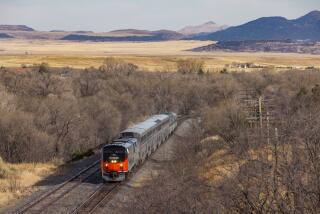‘Land Cruising in Style
- Share via
SANTIAGO DE COMPOSTELA, Spain — Un Crucero en Tren is the way the Spanish Narrow-Gauge Railway, FEVE (Ferrocarriles de Via Estrecha), billed its weeklong, 700-mile journey through the green wonderland of northern Spain. And it proved to be just that--a cruise on a train--complete with interesting regional (sometimes gourmet) food at every meal and sightseeing in a special FEVE air-conditioned bus that met the train at every stop and zoomed us off to the next sight--beach, cathedral or restaurant.
The train is called El Transcantabrico after the Cantabrian coast along which it runs. Spaniards also call northern Spain the Green Coast, because, well, it is very green. And it gets so because there is a lot of moisture . . . fog, mist, drizzle, downpour.
For the record:
12:00 a.m. May 23, 1999 For the Record
Los Angeles Times Sunday May 23, 1999 Home Edition Travel Part L Page 6 Travel Desk 1 inches; 29 words Type of Material: Correction
Spain train--Due to an editing error, photographs accompanying “Across Northern Spain” (May 16, 1999) were incorrectly credited. The photographs credited to Arthur Unger were taken by Raul Ruben Nunez.
But the rain in Spain didn’t dampen the spirits of adventure of the 49 tourists--including me and my friend, photographer and Argentine architect Raul Ruben Nunez--who had chosen to sign on last July for six nights and seven days on this Iberian Peninsula version of the Orient Express. I learned of the train through a mention in a small magazine for frequent travelers, and reserved our land passage through Marketing Ahead, a New York agency that I knew of because of its parador bookings.
Our route began in the seaside resort of San Sebastian and ended in the historic pilgrimage city of Santiago de Compostela (the opposite direction is also available). It meandered through the Spanish regions of Basque Country, Cantabria, Asturias and Galicia, loosely approximating the path from France to Santiago de Compostela that Christian pilgrims made on foot in the Middle Ages. Iberianophiles can expect to see a panorama of green landscapes--the tracks running through seeming virgin forests as well as cultivated fields, grazing livestock and clusters of tamarind trees (the ubiquitous tree of northern Spain).
How much space can a Toonerville-trolley-size train allot to each passenger? Well, there were four sleeping cars, each with eight compartments and two bathrooms. Each cabin held two bunk beds and a washbasin. For the most part, roommates in the standard compartments, $2,700 for two, were forced to dress at separate times since too many outstretched arms might have resulted in blackened eyes. However, for $600 more for two, FEVE recently added a car of suites that holds four deluxe compartments, each with its own bathroom and just about double the overall space of the standard compartments--relatively speaking, a very good deal. (The trip is so popular that its May-through-September season is sold out this year, but reservations are being taken for summer 2000. See Guidebook, this page, for details.)
We occupied one of the new suites and were fascinated by the state-of-the-art shower, a glass tube with its own electronic controls. When you closed the door, it said “Buenos dias” and proceeded to explain--in Spanish--how to turn on the hot water, the sauna, the massage feature, etc. Also inside were a radio, a telephone and a speaker that allowed the shower occupant to communicate with the outside world. Each compartment--suite and standard--had a picture window and controllable air-conditioning.
There were also three dining cars and a lounge/bar car with nightly dancing and entertainment by a talented singing guitarist. The drinks there are on you, one of the few expenditures most of us had to make. All meals, on and off the train, and all sightseeing expenses are included in the tour price. The train traveled by day and remained at a station siding each night so sleeping passengers wouldn’t miss anything. Eleven service personnel kept the compartments spotless, changing linens every day.
Then, of course, there was the diesel-powered engine car.
But what powered El Transcantabrico most effectively was our well-informed guide, Natalia, who spoke English, Spanish, German, French and Italian--and, on this trip, learned some words in Japanese--all of which came in handy since our fellow passengers included four Australians, two Germans, two Swedes, two Mexicans, three Japanese, five Americans and the rest--31--travelers from all over Spain.
The “voyage” got off to a fine start: We met in the lobby of San Sebastian’s most exclusive hotel, the Maria Cristina, where Natalia introduced herself and called the roll.
We sat down to a lunch in the hotel dining room that proved to be a harbinger of calories to come. As happened before every meal, we were presented with a special printed menu: rollotos de salmon con mantequilla de anchoas (smoked salmon roll with anchovy butter), brick de hongos y foie (mushroom and foie gras timbale), entrecote de buey a la Perigourdine (beefsteak with Perigord sauce), savarin de fruta del bosque (forest fruit salad), vinos and aguas minerales, coffee and liqueurs.
We walked off lunch with a tour of the old city of San Sebastian and a look at La Concha beach, a dazzling circle of white sand filled with sun worshipers. The air-conditioned Transcantabrico bus was waiting for us when we got back from our tour. We boarded and drove to Bilbao, Spain’s largest Basque city, where our main objective was to see the astounding new Frank Gehry-designed Guggenheim museum--which has been called both “the architecture of chaos” and “the most important building of the century.” The train, minus passengers, also proceeded on to Bilbao, where it would be waiting for us at the FEVE station in town.
After a tour of the city and a welcome aboard the train, we had a Basque meal featuring various forms of salt cod, the ubiquitous Spanish bacalao, at the restaurant Iza in the San Roque Hotel, a building that started out as a 16th century nunnery.
Then back to the train, which would be making its overnight stay on a siding at Balmaseda Station in the outskirts of Bilbao. Some passengers managed to retire to the lounge car for liquid refreshments, dancing and singing. Others simply retired to their compartments since, by this time, it was almost 1 a.m., the hour many evenings ended on this trip because dinner was inevitably served after 10. But since lunch ended around 3 p.m., most of us were soon comfortable with Spanish late-dining schedules.
A varied breakfast buffet was usually served at 9 a.m., after a tinkling wake-up chime, just as the train started moving. It was one of the best times of the day for those who enjoy eating in motion, and usually included fresh orange juice, cheeses, cold cuts, rolls, toast, danish and coffee.
For the next seven days, it was one long whirl of train, bus, restaurant, sightseeing, drinking, dancing and singing in the lounge car. And after the first day it became fun to categorize other passengers in secret. We designated as “The Singing Lolitas” a group of mature Andalusian sen~oras who broke into song at the slightest provocation . . . everything from folk songs to “Amapola.”
The three proper matrons from Yokohama, impeccably dressed in designer outfits, spoke both Spanish and English, and proved to have great senses of humor--especially when we playfully accused them of traveling incognito and actually being “The Tokyo Tango Trio,” a group of Japanese dancers that recently toured Argentina.
The best sport on board, however, was a 6-foot-2 Australian whose bunk bed was only 6 feet long. He claimed not to have slept a wink during the entire week, and dozed in the bus now and then.
Speaking of the bus, it became our habit to applaud the last people to climb aboard . . . and it was constantly “The Honeymooners,” two handsome youngsters from Madrid who had chosen to spend their honeymoon locked in a tight compartment. What they didn’t choose was to experience it without their luggage. Iberia Airlines had lost their baggage on the flight from Madrid, and there were lots of leering suggestions that perhaps it was meant to be. But they seemed uncomfortable in their tired shorts. The luggage arrived in a few days, but not before the other ladies on the cruise got together one night and, from their own meager wardrobes, provided the bride with a stylish outfit to wear on the evening the tour visited the casino in Santander.
Santander, the capital of Cantabria, is an elegant resort that extends along the coast around the Peninsula de la Magdalena, a headland on which there is a park, a zoo and the 1912 Palacio de la Magdalena. That evening at the chic Belle Epoque casino, we watched a mysterious sen~orita bet a $7,000 chip (she lost it).
We lunched the next day at a parador--one of Spain’s government-sponsored hotels, often in historic buildings--in the picturesque town of Santillana. The French existential philosopher Jean-Paul Sartre called Santillana “the most beautiful village in Spain.” Even though now a bit manicured and boutiqued, it is graced by a tableau of 15th to 17th century golden stone houses; the Romanesque monastery La Colegiata; and, in the center of town, the mansion-turned-parador Gil Blas, where we ate.
Once in the Picos de Europa--the beautiful mountain range, now Europe’s biggest national park, that straddles Asturias and Cantabria--we took a cable-car ride to one of the highest peaks in Europe, followed by a visit to the sanctuary of Covadonga. There we saw a cave where the Virgin Mary is said to have appeared in the Middle Ages.
Another highlight was our group’s candlelight dinner in the pretty resort of Comillas, known for its unusual buildings by architects such as Antonio Gaudi. We ate in El Capricho de Gaudi, an early building by the architect, now restored, that houses a sophisticated restaurant. The building is a fantastical example of the Christian-Islamic hybrid architectural style known as Mudejar, with a minaret-like tower covered in green and yellow tiles.
A little farther on, we were thrilled by two pre-Romanesque churches on Mt. Naranco overlooking the town of Oviedo, the cultural and commercial capital of Asturias. They were Santa Maria del Naranco and nearby San Miguel de Lillo.
The day before disembarking, we had our most superb marisco (seafood) meal at the Parador del Ferrol in Spanish dictator Francisco Franco’s home town of El Ferrol. We feasted on mussels, clams, four varieties of crabs, including spiders and kings, and large lobster-like shrimp called cigalas, a meal that would have cost $100 or more anywhere in Spain.
Finally we arrived in Santiago de Compostela, a beautiful city that is the centerpiece of Galicia. Around the square known as Praza do Obradoiro are historic buildings with few equals in Europe.
We spent an hour at the cathedral before meeting for a final meal at the exquisite Hotel Reyes de Catolicos, founded in the 16th century as a hostel for pilgrims--now a grand parador. Hardly the spartan fare of pilgrims, lunch consisted of pork salad, scallops au gratin, sirloin of Galician veal in wine sauce, fruit, almond cake and crepes, plus red wine, a superb rose and a choice of liqueurs.
The Transcantabrican pilgrims exchanged hugs, fax numbers and e-mail addresses because close friendships had been formed in the close quarters of the little train.
(BEGIN TEXT OF INFOBOX / INFOGRAPHIC)
GUIDEBOOK
The Train in Spain
Getting there: To get to either departure point, fly L.A.-Madrid with one change of planes (no direct or nonstop) on US Airways, American, Continental, Delta, Swissair, British Airways or TWA; fares begin at $810 round trip. From Madrid take the train or fly Iberia nonstop to San Sebastian ($114 round trip) or Santiago de Compostela ($103).
The train: Runs from San Sebastian to Santiago de Compostela, or the reverse. Tour price is about $2,700 for two in a standard compartment, about $3,300 for two in a suite, including seven days/six nights of train travel; all sightseeing; all meals, on and off the train, with bottled water, wine and coffee. The train runs May through September. This year’s departures are completely booked, but reservations are being taken for next year. There are spaces on a special millennium departure Dec. 28 from Santiago de Compostela to San Sebastian; standard double $5,000, suite $6,000.
Book through a travel agent or a booking agency such as Marketing Ahead, 433 Fifth Ave., New York, NY 10016; telephone (800) 223-1356, fax (212) 686-0271.
For more information: Tourist Office of Spain, 8383 Wilshire Blvd., Suite 956, Beverly Hills, CA 90211; tel. (323) 658-7188, fax (323) 658-1061, Internet https://www.okspain.org.
More to Read
Sign up for The Wild
We’ll help you find the best places to hike, bike and run, as well as the perfect silent spots for meditation and yoga.
You may occasionally receive promotional content from the Los Angeles Times.






